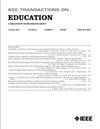“These Different Ideas, Traditions, and Values Make My Thinking Unique and Creative”: Bringing Native Hawaiian Ways of Knowing to Engineering Education
IF 2.1
2区 工程技术
Q2 EDUCATION, SCIENTIFIC DISCIPLINES
引用次数: 0
Abstract
Contribution: This article focuses on the study of Native Hawaiian student experiences in engineering education. Telling these stories illustrates the importance of legitimizing and appreciating different knowledge types in engineering as we move toward a more inclusive and sustainable field. Background: Native Hawaiian engineering students live oppressive realities due to the history of settler colonialism and occupation that attempted to erase their culture and ways of knowing, including in engineering education. This study shows how students overcome these realities to enact their ways of knowing in a field where it is not always respected. Informing the field of ways to promote and respect the different knowledge types of marginalized groups can help to create a more inclusive and sustainable engineering field. Research Question: In what ways do Native Hawaiian students bring their cultural ways of knowing into engineering education? Methodology: We conducted semi-structured interviews with three undergraduate Native Hawaiian students using Manulani Aluli Meyer’s Holographic Epistemology as a theoretical lens to inform the questions and qualitative analysis. The analysis uses a combination of inductive and deductive analyses to create the hologram that Meyer outlines in her work. Findings: The participants found different ways to enact their cultural ways of knowing. We interpret them through the Native Hawaiian values of pono, kuleana, and hō‘ihi. This illustrates how engineering educators, researchers, and programs can legitimize the knowledges of the students by promoting authenticity and reciprocity toward marginalized students and their ways of knowing."这些不同的思想、传统和价值观使我的思维独特而富有创造性":将夏威夷原住民的认知方式引入工程教育
贡献:本文重点研究夏威夷原住民学生在工程学教育中的经历。讲述这些故事说明,在我们迈向一个更具包容性和可持续性的领域时,使工程学中的不同知识类型合法化并对其加以欣赏非常重要。背景:夏威夷原住民工程专业的学生生活在压迫性的现实中,这是因为殖民殖民主义和占领的历史试图抹杀他们的文化和认知方式,包括工程教育中的文化和认知方式。本研究展示了学生们如何克服这些现实,在一个并不总是受到尊重的领域中形成自己的认知方式。让该领域了解如何促进和尊重边缘化群体的不同知识类型,有助于创建一个更具包容性和可持续发展的工程领域。研究问题夏威夷原住民学生是如何将他们的文化认知方式带入工程学教育的?研究方法:我们使用 Manulani Aluli Meyer 的全息认识论作为理论视角,对三名夏威夷土著本科生进行了半结构式访谈,为问题和定性分析提供依据。分析采用归纳和演绎分析相结合的方法,以创建 Meyer 在其著作中概述的全息图。研究结果参与者找到了不同的方式来表达他们的文化认知方式。我们通过夏威夷原住民的 "pono"、"kuleana "和 "hō'ihi "价值观来解释这些方式。这说明了工程教育者、研究人员和项目如何通过促进对边缘化学生及其认知方式的真实性和互惠性,使学生的认知合法化。
本文章由计算机程序翻译,如有差异,请以英文原文为准。
求助全文
约1分钟内获得全文
求助全文
来源期刊

IEEE Transactions on Education
工程技术-工程:电子与电气
CiteScore
5.80
自引率
7.70%
发文量
90
审稿时长
1 months
期刊介绍:
The IEEE Transactions on Education (ToE) publishes significant and original scholarly contributions to education in electrical and electronics engineering, computer engineering, computer science, and other fields within the scope of interest of IEEE. Contributions must address discovery, integration, and/or application of knowledge in education in these fields. Articles must support contributions and assertions with compelling evidence and provide explicit, transparent descriptions of the processes through which the evidence is collected, analyzed, and interpreted. While characteristics of compelling evidence cannot be described to address every conceivable situation, generally assessment of the work being reported must go beyond student self-report and attitudinal data.
 求助内容:
求助内容: 应助结果提醒方式:
应助结果提醒方式:


